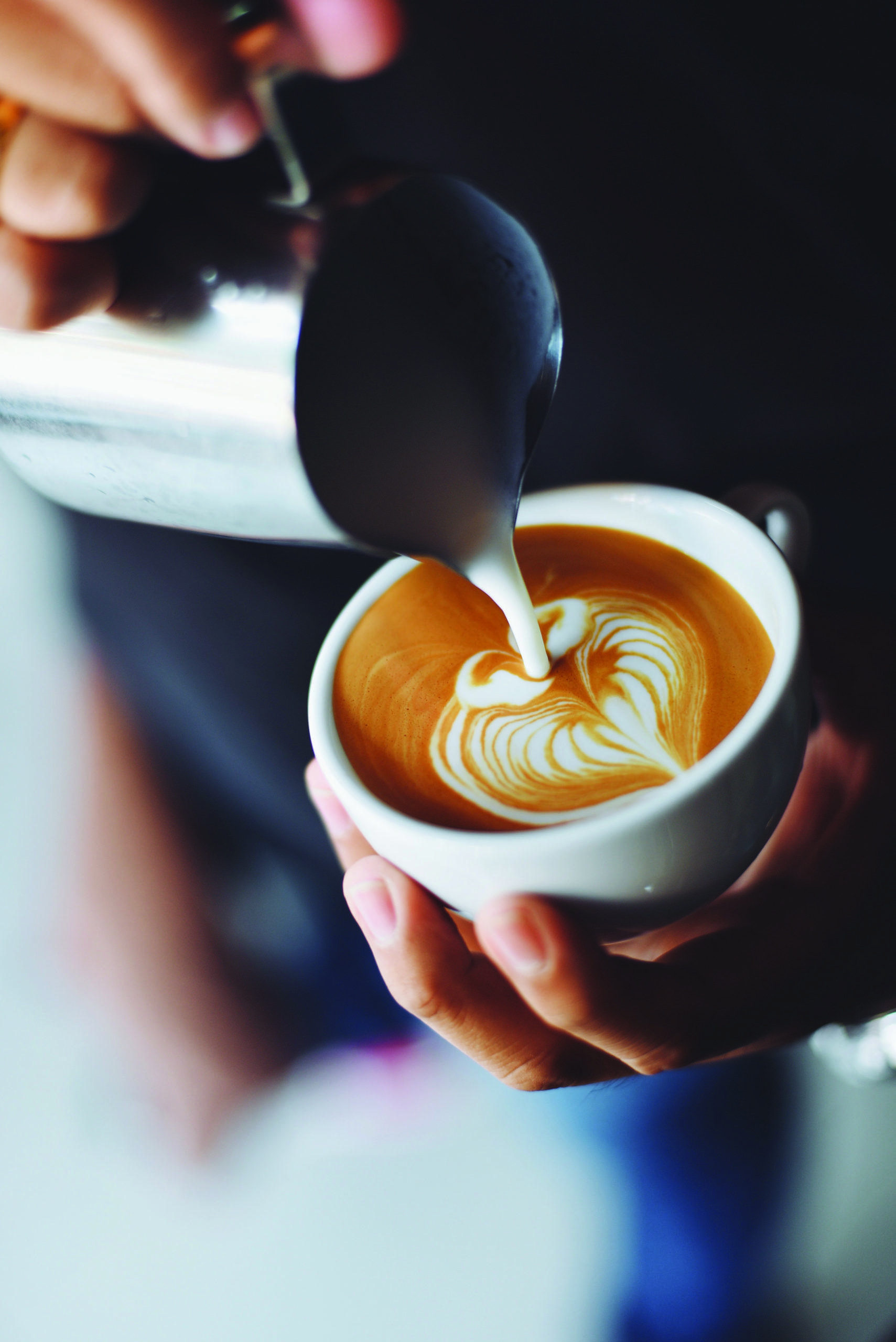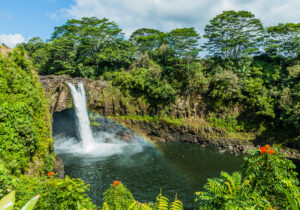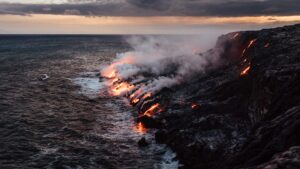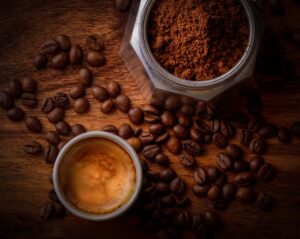Our Coffee, Cloud Forest & Brewery Tour makes a stop at Mountain Thunder Coffee to get a first-hand education on Kona coffee. Kona is famous for coffee and Carta Coffee Merchants gives us a guide to this delicious coffee.
There’s something special about Kona, Hawaiʻi. It’s in this place—amongst the ocean-lined landscapes and rainbow-filled valleys—that grows some of the Earth’s best and most exclusive coffee varietals.
Even though the State of Hawaiʻi claims eleven coffee regions spread across the volcanic island chain, one small region on the Big Island—often called Hawaiʻi’s Coffee Belt—has made its name as an iconic, internationally recognized coffee powerhouse.
So, what is it that makes coffee from the Kona District so iconic, delicious—and expensive? Let’s find out.
WHAT IS KONA COFFEE?
Some of the most favorable coffee-growing conditions in the world exist on the Big Island of Hawaiʻi, specifically in the North and South Kona Districts. The trees are grown on the slopes of Hualalai and Mauna Loa, two of the largest and most active volcanoes on the planet.
Coffee trees thrive in very specific climates and conditions—and Kona happens to match the plant’s preference perfectly. With rich minerals provided by the volcanic soil and weather that switches from sunny mornings to rainy afternoons, this little slice of paradise cultivates the only coffee on Earth that can be called “Kona.”
WHAT ISN’T KONA COFFEE?
If you want to ensure that you’re consuming real 100% Kona coffee, then make sure to read the label. Much like how real champagne must come from Champagne, France, only coffee grown in Kona gets the title of Kona coffee. It’s actually Hawaiʻian law that the amount of pure Kona coffee within a package must be accurately represented.
Furthermore, anything labeled a blend must contain at least 10% real Kona coffee. Though these blends will have some actual coffee grown in Kona, Hawaiʻi, in reality, it contains little of the real thing. The rest typically comprises of cheaper, Central American Arabica beans. It might be a decent cup of coffee, but you can’t call it 100% Kona Coffee.
In order for your coffee to be deemed 100% Kona Coffee, it must be grown in Kona, Hawaiʻi and it must not contain any blend of other beans. The coffee must be comprised of beans strictly grown in Kona Coffee. As we mentioned above, anything with other beans present in a mix must be labeled as a blend and the amount of Kona coffee must be represented on the packaging.
If you’re looking for the best tasting Kona coffee you can get, be sure that the coffee is 100% pure Kona Coffee and not a blend.
A BRIEF HISTORY OF KONA COFFEE
The coffee tree isn’t native to the Hawaiʻian Islands. Instead, it likely originated in Ethiopia before making its way west to South America. So, how exactly did Hawaiʻi—and more specifically Kona—become a world-renowned coffee destination?
It all started back in 1828 when Samuel Reverend Ruggles first planted a coffee tree in the Kona. Though he first tried to get the coffee industry to take off on the island of Oahu, it was the volcanic sands, mixed elevations and ideal weather that made Kona perfect. By the end of the 19th century, about three million coffee trees were growing on the Big Island of Hawaiʻi.
Currently, there are about 790 coffee farms and plantations on the Big Island—with the far majority working as small, independent enterprises. These farmers often use the same methods that their families have employed for generations. Though new technologies may emerge in other coffee growing regions of the world, tradition remains strong in Kona. When touring coffee farms and plantations, expect to see workers harvesting, drying or roasting coffee the old-fashioned way.
HOW IS KONA COFFEE HARVESTED?
Kona coffee grows on lush farms located within the rolling hills beneath Hawaiʻi’s most famous volcanos.
In February and March, white flowers known as “Kona snow” begin blooming on trees around the island. By April, small green berries appear. By August, they turn into red fruit known as a “cherry” for harvesting. Each tree typically produces between ten and fifteen pounds of coffee cherries annually, which ultimately becomes about two pounds of dried coffee beans.
Once the cherries are picked, it’s off to be dried out, processed and turned into Kona coffee beans. It takes about 10 lbs. of cherries in order to make approximately 1-2 lbs. of finished Kona coffee.
HOW IS KONA COFFEE DRIED AND PROCESSED?
There are several different methods to dry and process Kona coffee. Since many Kona coffee producers stick to their roots, most of these methods are similar—if not exactly the same—as how coffee was processed by their family generations ago.
The most common way to begin processing fresh coffee cherries is by separating the inner bean from the cherry’s fruit using a pulper. Once separated, the beans are soaked overnight. Then, they’re laid out on a drying rack for approximately 14 days—or until the moisture level reaches between 10 and 13%.
Next, the finished coffee beans are classified by grade based on size, shape and quality. Once sorted, the green Kona coffee beans are ready for roasting.
HOW IS KONA COFFEE ROASTED?
Like in most coffee producing regions, different coffee roasters might employ different coffee roasting techniques. However, since most farms on Kona are smaller, there is a higher percentage of Kona coffee that’s roasted using small-batch, natural and traditional methods.
Kona coffee beans are roasted in a heated drum that turns consistently throughout the process, ensuring all beans are roasted on all sides. Roasting times generally range from 12 to 30 minutes, but those minutes are pivotal to the quality of the final product. As the beans expand and lose moisture, this causes the formation of soluble oils which are essential to the overall flavor profile.
Whether or not the coffee is a light or dark roast all depends on the roasting time. Light roasts are taken out after the bean’s first crack, while dark roasts are left inside the drum until the beans begin to smoke. Full roasts, sometimes referred to as Viennese or Italian Espresso roasts, have a heavier body and may even seem spicy with their strong flavors.
WHY IS KONA COFFEE SO EXPENSIVE?
There’s no one reason why Kona coffee tends to be more expensive than coffee from other regions of the world. Instead, it’s a culmination of several different factors.
SMALL GROWING AREA
Unlike massive coffee growing regions like Brazil, Vietnam or Colombia, the Kona region is incredibly tiny. For comparison, Brazil clocks in at producing around 5.7 billion pounds of coffee annually, Vietnam at 3.6 billion and Colombia at 1.7 billion. Kona coffee only produces about 24.3 million every year.
Since 100% Kona coffee is such a sought after commodity, there’s simply little supply and lots of demand which spikes prices way up.
HIGHER PRODUCTION COSTS
Because of the United States’ tougher regulations, higher cost-of-living and wage laws, it costs more to produce coffee in Hawaiʻi vs. other regions. In the U.S., coffee producers pay their employees minimum wage which is typically substantially higher than what workers get paid in developing nations, where much of the world’s coffee is growing.
Though paying people a living wage and ensuring companies are up to industry standards are all great things, the added expenses are passed along to consumers.
SMALLER, SUSTAINABLE PRODUCTION METHODS
Lastly, most farms on Kona—including our own—are smaller, family-owned farms dedicated to using more traditional, slower, small-batch coffee production methods. This often means hand-picking every bean, air or traditionally drying the beans and hand-roasting every batch. Consumers will experience more complex and unique flavors—as well as higher labor costs.
These methods all create better, more sustainable beans, but do cost more than the mass production seen on larger factory farms. Like the higher production costs, additional costs are passed down to the consumer—but isn’t it worth it for an incredible, cup of coffee?





